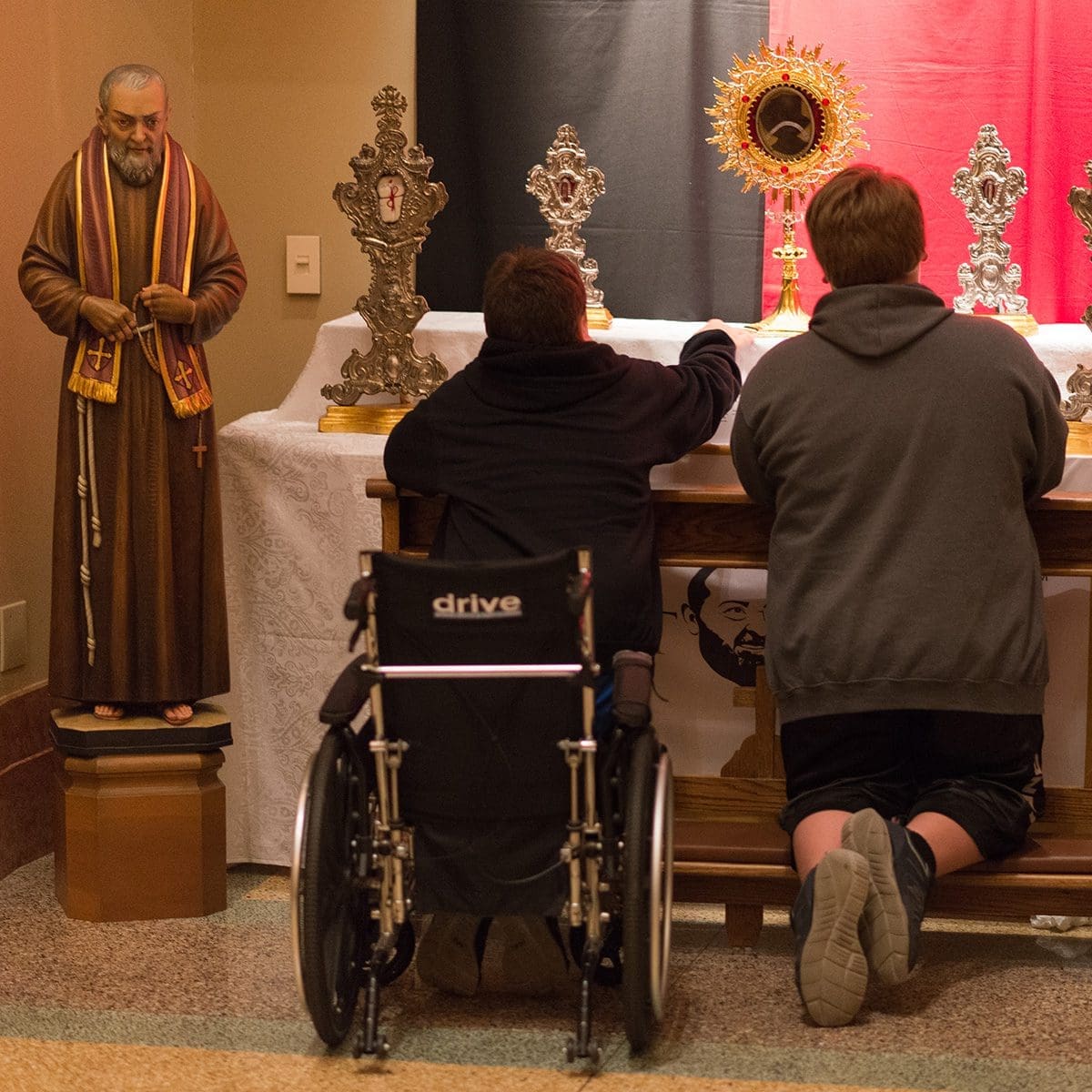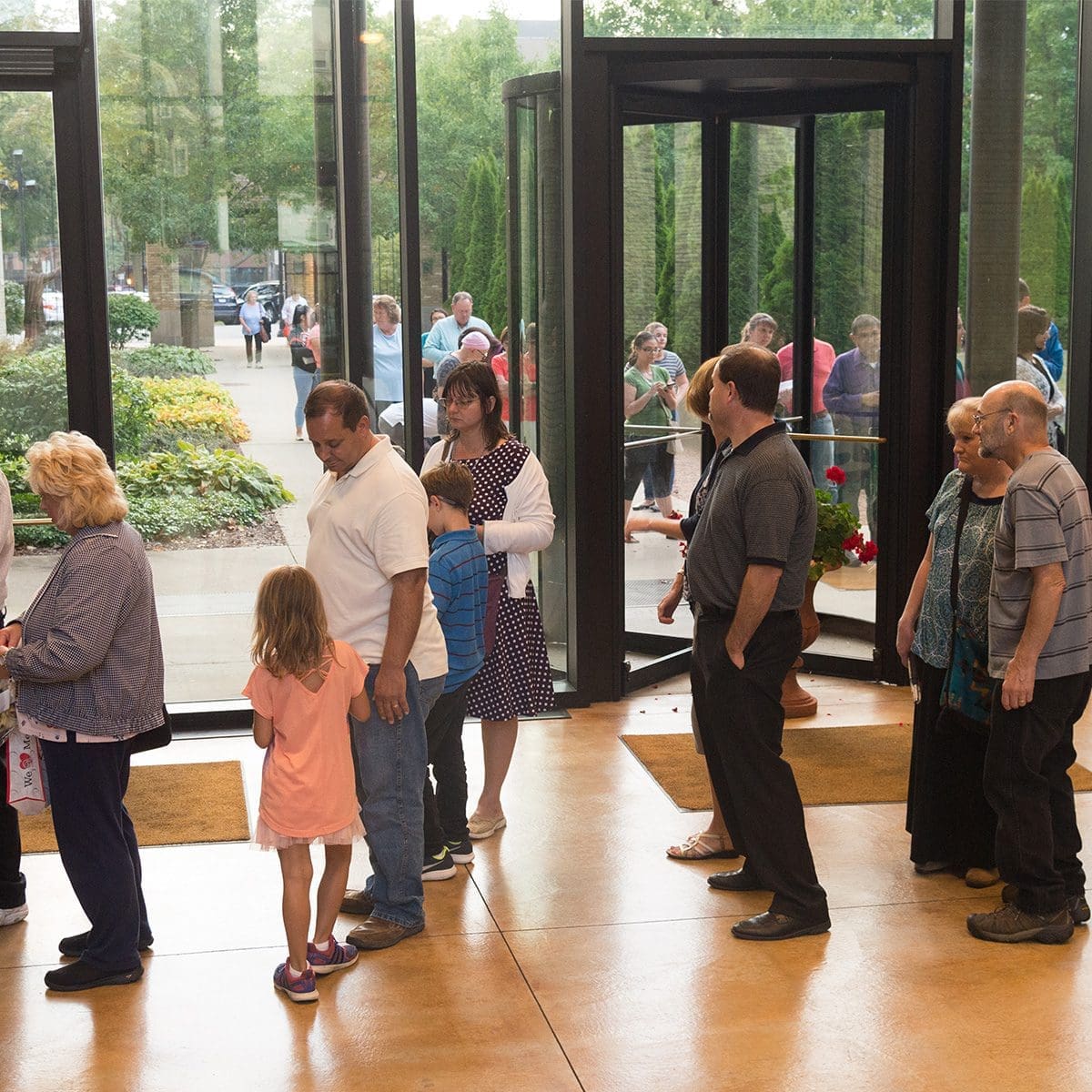Rose Figueiredo and her unborn baby stood in line at the Cathedral of St. John the Evangelist in downtown Milwaukee to see the relics of St. Pio of Pietrelcina, also known as Padre Pio. Due with a baby next month, she said her family prayed at the shrine of Padre Pio in Goa, India, and asked that she become pregnant.
“When I found out the relics were going to be so close to me, I couldn’t miss the opportunity to see them,” Figueiredo, who lives in Whitefish Bay, said.

A statue of St. Padre Pio “watches over” those attended to venerate the items. (Photos by Pete Fenelon)

The relics were very popular, with long lines throughout much of the 12-hour event.
The relics of Padre Pio made a stop on their tour of the country at the Cathedral of St. John the Evangelist on Thursday, Sept. 21. From morning until night, community members stood in line — sometimes a line so long it was out the door of the Cathedral — to pray before the relics of the saint. The relics have traveled the around the United States since mid-September and will continue to do so until the beginning of October.
Community members kneeled before St. Pio’s glove, the crusts of his wounds, cotton gauze with his blood stains, a lock of his hair, his mantle and a handkerchief soaked with his sweat hours before he died. Many touched rosaries or necklaces to the vessels with these objects. Touching or praying in the presence of such objects helps an individual focus on the saint’s life and virtues so that he or she might be drawn closer to God.
The Saint Pio Foundation is sponsoring the tour on the occasion of the 130th anniversary of Padre Pio’s birth, and the 15th anniversary of his canonization.
Kathy Uhl’s eyes filled with tears as she described how she prayed years ago to Padre Pio for her daughter to be healed of cancer. She wears his medal and was honored to pray before his relics.
“It was so spiritual,” she said. “It filled my heart with joy. It filled this inner peace. I was blessed to have that experience and to see so many others have that experience.”
Steve Gaenslen of Milwaukee had a similar reaction when talking about the chance to pray before the relics. He is a member of the Padre Pio prayer group, a group of about 20 Catholics across the archdiocese. The group gets together the first Saturday of every month to pray for priests.
“It’s wonderful the relics are here,” he said as a huge smile spread across his face. “I have such a devotion to Padre Pio. I made it a point to retire on his feast day a year ago.”
Bishop Jeffrey Haines celebrated Mass that evening at the Cathedral in honor of St. Padre Pio. In his homily, he addressed how the saint is associated with many spectacular physical features, such as his ability to levitate and the stigmata, the term the Catholic Church uses to speak about the wounds an individual receives that correspond to the wounds of Jesus Christ at the crucifixion, often appearing on the hands, wrists and feet. However, Bishop Haines said, Padre Pio was focused on living more closely to Jesus, because living with piety is to draw attention to Jesus Christ.
“He downplayed his spectacular features and is famous for saying, ‘I’m only a friar who prays,’” Bishop Haines said in his homily.
St. Padre Pio was born May 25, 1887, in Pietrelcina, Italy, and was baptized Francesco Forgione. He first expressed desire for priesthood at the age of 10. To afford the education needed to become a priest, his father immigrated to the United States.
The future saint entered the Capuchin order at the age of 15 and took the name Pio. He was ordained a priest at the age of 23, in 1910.
During World War I, Padre Pio had a vision in which Christ pierced his side and he started to receive wounds on his hands and feet that reflected the wounds of Jesus on the cross. A few weeks later, Jesus appeared to him again and he received the full stigmata, which remained with him until his death.
Padre Pio was known as a mystic in his lifetime, with miraculous powers of healing and knowledge. His feast day is Sept. 23. He is the patron of civil defense volunteers, adolescents and the village of Pietrelcina.
